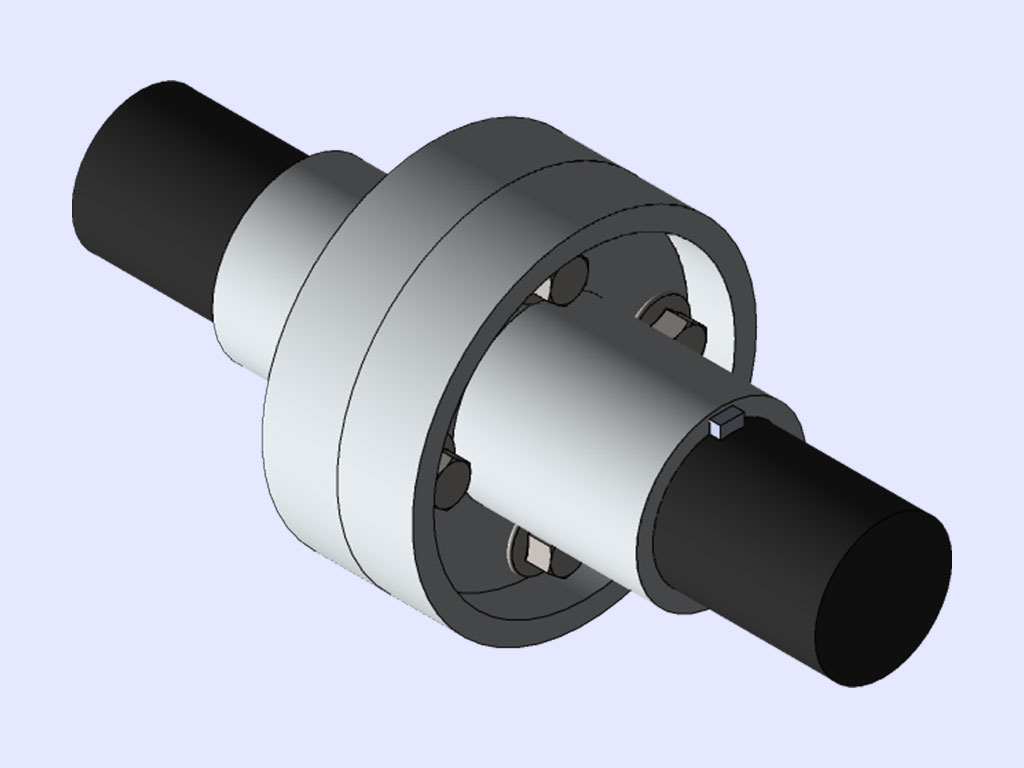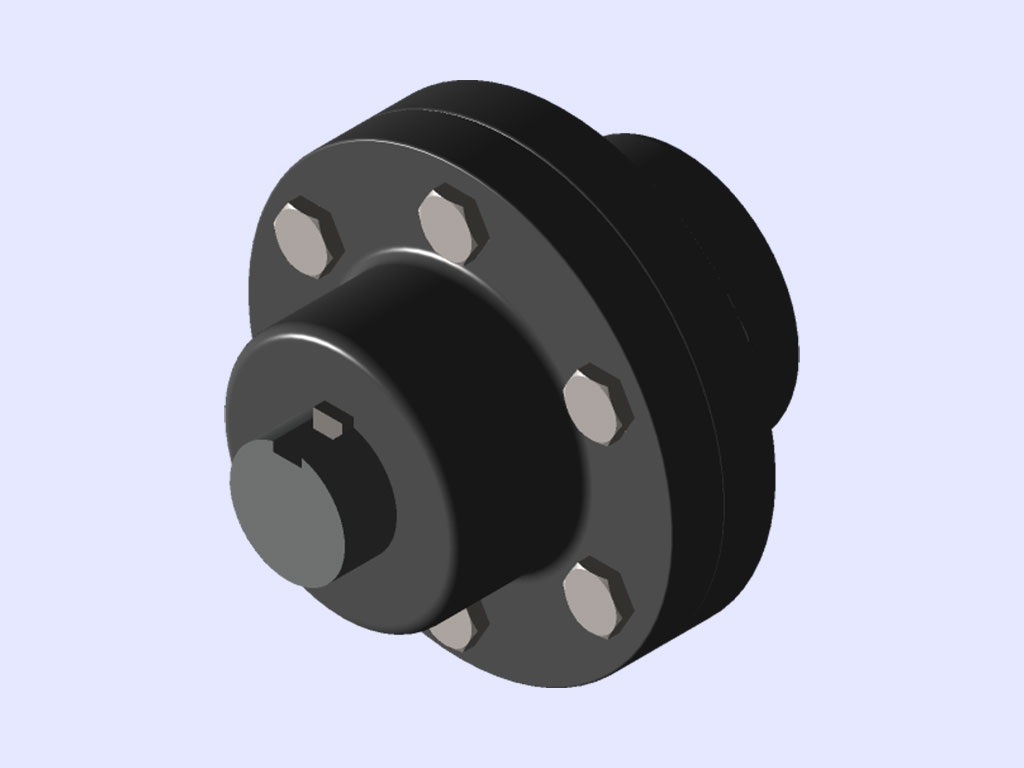Flange coupling is the most crucial part observed in different machines and structures in countless ways. Flange coupling are widely used because of their ability to connect the gap between two freely rotating shafts. In different mechanical systems these flanges are used as connectors to build a seamless transfer of the power. Check out this blog to explore some interesting facts, design, benefits, application of the flange coupling.
What is Flange coupling?
Flange coupling is simply a type of mechanical device which is generally used for connecting two different shafts. These shafts are joined together for transmission of power or torque from one to another shaft. The flanges are mounted at the end of a particular shaft in order to make connections using bolts, gaskets and nuts etc. Flange couplings are designed with accurate alignment, high torque transmission, resistance to vibration and more for better application.
Components of flange coupling
There are particular two shafts in flange coupling each of which is joined at the end portion of the shaft. The flanges on the end are joined together using preferable bolts or gaskets with specific sealing mechanisms. You can observe a great variation in the design of the flange coupling. But in general Flange coupling are made with following main parts:
Flanges
Flanges are simple circular plates which contain several holes along the circumference to fit in with bolts. These are generally made from the materials like steel, iron, cast or aluminum to increase the durability and strength of sealing.
Bolts
Bolts are fitted into the holes of the flanges and are tightened up. This procedure will intact two flanges securely together.
Gasket or seal
A gasket or seal is generally placed in between the flanges in order to prevent leakage of fluid or lubricants flowing via pipe. Also, these are perfect to maintain proper alignment of the shaft to avoid any sort of crack issues.
How does flange coupling work?
Flanges placed in between the two different shafts and bolted together to make them mechanically linked. The process of rotating one shaft creates a torque which is then transmitted to another shaft via flange coupling. Also, the presence of the seal or gasket in between the flanges minimizes the chances of the leaks or contamination of fluid flowing in the pipe.
Types of Flange coupling
There are mainly three different types of Flange coupling which are mostly used in industrial areas.
Protected Flange Coupling

In the design of this flange there is presence of protective covering or shield at the place of assembly. Hence, it is named as protected flange coupling. Due to the protective enclosure design of this coupling, it protects the sealing from external sources of contamination. It mainly includes moisture, debris, dirt, dust etc. It also works as a safety barrier providing protection against unexpected accidents with contact of rotating components of flange coupling.
Protected flange couplings are mostly applicable in industrial areas which demand more safety as well as long term reliability options. Protective parts of these enclosures are made from different materials like plastic, rubber, metal and more. These materials help in providing a safety against the harsh environmental conditions.
Unprotected Flange coupling

This flange coupling does not possess any additional layer of protection or shield around coupling. Hence, it is named as Unprotected Flange coupling. Each shaft here is connected with the main flange using a counter sunk key. Further, the flanges are connected through rings of bolts.
Unprotected flange coupling is installed in the area which faces lesser exposure to extreme environmental conditions. Basically, these are preferably inserted into areas which face lesser contamination or exposure for the moving parts. Unprotected flange coupling is installed mainly where the regular inspection, maintenance and services is carried out.
Marine Flange coupling

Marine flange couplings are specially designed and manufactured to apply in marine equipment and vehicles like ships and boats. The design of the flanges have the integral shafts. Based on the perimeter of the shaft the number of bolts is decided. Marine flange couplings have the presence of a tapered form of headless bolts. This design is engineered to help the flange coupling tolerate the unique type of challenges that come up in marine environments. It mainly includes conditions of corrosion. High humidity, constant exposure to saltwater and more.
Marine flange coupling is exclusively composed of the material which is highly resistant to corrosion, like stainless steel or non-corrosive alloys. These are designed in a particular manner which allows it to withstand the heavy vibration conditions or else constant exposure to moisture. Due to such features, Marine flange couplings are mostly applicable in the engine or motor with propellers present in the marine vessel. Hence, it helps in maintaining efficient power transmission in marine vehicles.
What are the different materials used in the flange coupling?
Flange couplings are crucial parts in different mechanical and industrial systems. It is important to select the proper material of the flange coupling which helps to ensure reliability, durability and performance at point of application. There are different factors which influence the selection of material of flange coupling. Some of which are temperature, pressure, environment around flange, role of coupling etc. Check out some of commonly available flange coupling material as follows:
- Carbon steel
- Stainless steel
- PVC
- Cast iron
- Composites
Application of flange coupling
Flange coupling is most applicable for medium to heavy duty work. Due to its versatile features, flange coupling are a preferable choice of following industrial areas:
Industrial machinery
Flange couplings are applied in industrial machinery to effectively transmit the power. Therefore, these are applied to compressors, pumps, conveyors and other types of industrial machinery.
Automotive industry
An important part of the drivetrain component is flange coupling. Here it is installed between the transmission and driveshaft to connect them.
Marine engineering
In the marine industry, flange coupling is installed to connect the propeller shaft and output shaft of the engine. Hence, it plays a significant role in marine propulsion systems.
Aerospace
In the aerospace industry, flange coupling is employed in aircraft and spacecraft for connection of different rotating components. Thus, it will ensure a precise and secure transmission of power.
Energy sector
Use the flange couplings for connection of the turbines, different equipment and generators etc. Hence, flange couplings are made to use in traditional as well as renewable energy production plants.
Benefits of Flange couplings
Flange couplings offer many benefits which makes it an ideal choice for application in industrial areas. These are as follows:
High torque transmission
Flange coupling has a special design which makes it able to tolerate the high values of torque. Therefore it is suitable to make a heavy-duty application in industries.
Vibration dampening
Flange couplings can effectively damp th4e vibrations coming into machinery and vehicles. Due to the fitting of flange coupling even after facing heavy vibrations, these machines run smoothly and quietly.
Ease of maintenance
Flange coupling is much easier to install and even maintain. All thanks to their simple but effective design.
Precise alignment
There is presence of bolted design in flange coupling. Thus, it helps in making precise alignment of the shafts which ultimately reduces wear and tear. It will indeed benefit to maintain longevity of connected components through the shaft.
What are the considerations to undertake while using flange coupling?
Flange couplings help to enjoy various benefits when you install and maintain it with following these considerations.
Material selection
Choose the material of the flange coupling which should be able to tolerate the operating conditions of point of application in industries. It includes temperature, pressure and other corrosion through fluid involved in transportation.
Alignment
Proper alignment of the flange coupling is important to consider for avoiding any sort of premature wear and tear in machinery.
Tightening of bolts
Follow proper torque and sequences when it is essential to do proper tightening of bolts. Also, the accurate tightening of bolts is essential to maintain integrity of flange coupling connection.
Maintenance
It is important to ensure some regular inspection and maintenance to ensure the optimal functioning of flange coupling.
Conclusion:
Flange coupling is one of the unsung heroes which plays an important role in the rotating mechanical system. But sometimes these might get out of the spotlight but once after knowing about its advantages you would definitely include it in the list. It has the ability to damp the vibration and reliably transmit the power. Therefore, flange coupling is one among the indispensable choices of industries.
It is important for the engineers to understand the flange design, mechanism, considerations etc to effectively install, maintain and make a smooth running of machines. From now whenever you find a machine running efficiently and smoothly remember the flange couplings are high on work behind the curtain.
FAQs
What is the application of flange coupling?
Flange coupling is generally utilized in areas which need to handle high pressure in a piping system where meeting of two pipes is essential.
What is the main function of flange coupling?
Flange coupling are mainly used for making connections of pipe to fittings, specialty items like pressure vessels trainers and more.
How is the flange bolt used?
The flange bolt is used in many different ways to make a specific application in connection with pipe fittings and plumbing purposes.
Why is flange coupling widely used in industries?
Flange couplings are primarily used in industries to connect two different pieces of rotating equipment to transmit the power efficiently.
What are the flange coupling bolts subjected to at point of application?
Flange couplings at point of application are directly subjected with shear stress and lesser amount of torsional shear stress.




